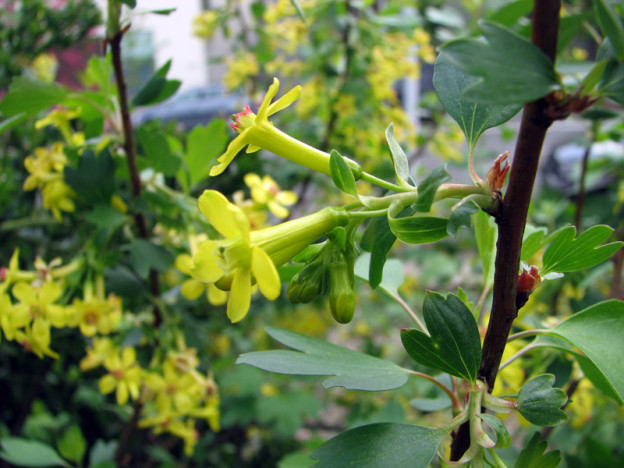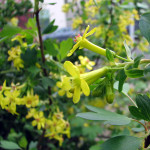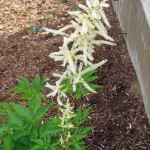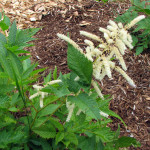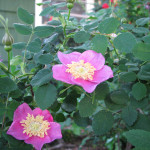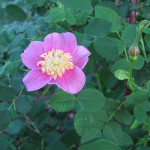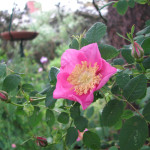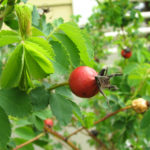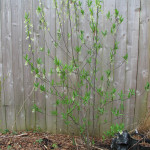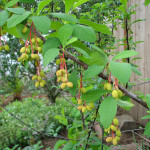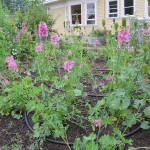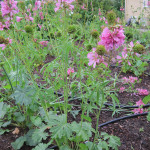Ribes aureum
Golden currant (Ribes aureum) is a small to medium-sized deciduous shrub named for its golden flowers and golden red fall foliage. It is common in Oregon and Washington east of the Cascades and into the Great Basin.
Golden currant grows in full sun and partial shade, in dry to moist conditions, and is drought tolerant. The leaves are deciduous, lobed, and vaguely maple-like, ½ – 1½ inches. Charming clusters of yellow flowers bloom from mid- to late-spring. Golden currant grows to approximately 6 feet tall by 6 feet wide.
It attracts hummingbirds and butterflies such as the spring azure and mourning cloak, and the fruit is eaten by birds and other wildlife. Combine this in a sunny spot with its cousin, red-flowering currant, and drought-tolerant groundcovers like alliums and camas, for a beautiful native display!
- Light Requirements: Full Sun, Part Shade
- Water Requirements: Dry, Moist
- Ease of Growing:
- Growth Rate: Moderate
- Spreads: No
- Wildlife Support: Hummingbirds, Birds or Mammals
- Fire-resistant: No
- Edible: Yes
- Mature Height: 6ft
- Mature Width:6ft
Goat’s Beard

Aruncus dioicus
Goat’s Beard has decorative finely-cut foliage and will create a bold, showy effect for a moist or partly-shaded spot all season. Dense, feathery plumes of tight white flowers rise well above the foliage spring to summer.
Goat’s Beard is an excellent background plant or grouped in a woodland setting. It dies back to the ground in winter, only to return gloriously in the spring. Goat’s Beard spreads slowly by rhizomes to form attractive patches, and can be planted in more sunny areas provided there is good moisture. It’s a “host” plant to the Dusky Azure Butterfly.
- Light Requirements: Part Shade, Full Shade
- Water Requirements: Moist, Perennially Wet
- Ease of Growing: Easy to grow
- Growth Rate: Fast
- Spreads: Yes
- Wildlife Support: Pest-eating Insects, Birds or Mammals, Pollinators
- Fire-resistant: No
- Edible: No
- Mature Height: 5-15ft
- Mature Width:3-5ft
Grand Fir

Abies grandis
Grand fir (Abies grandis) is a shade tolerant, slow-growing evergreen tree with short, dense branches. It can get quite tall in the wild, reaching 250 feet in height and with a trunk diameter of up to 6 feet.
The glossy dark green leaves are needle-like, 3-6 cm long, and extend flat out from the branch on either side. The 6-12 cm cones do not fall to the ground whole, but disintegrate on the tree and release their seeds about 6 months after pollination.
Grand fir is an important wildlife tree. The California tortoiseshell butterfly feeds on the sap and secretions from cones and needles. Grouse eat the needles, and nuthatches, chickadees, and squirrels eat the seeds. Grand firs also provide excellent cover and nesting habitat for birds and small mammals.
The foliage has an attractive tangerine-like scent, and Grand Firs are sometimes used for Christmas decoration, including as Christmas trees. It is also planted as an ornamental tree in large parks.
Grand fir needs well-drained soils and plenty of room to grow, and is an elegant addition to any landscape.
- Light Requirements: Full Sun, Part Shade, Full Shade
- Water Requirements: Moist, Seasonally Wet
- Ease of Growing: Easy to grow
- Growth Rate: Moderate
- Spreads: No
- Wildlife Support: Hummingbirds, Pest-eating Insects, Birds or Mammals
- Fire-resistant: No
- Edible: No
- Mature Height: 200ft
- Mature Width:40ft
Nootka Rose
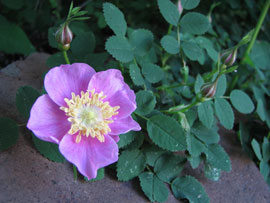
Rosa nutkana var. nutkana
The Nootka rose is an attractive shrub growing up to 9′ high. The straight, erect stems are usually green, but occasionally may be reddish. The prickles are larger and thicker than those of the other native rose species.
The leaves are alternate on the stems and pinnately compound with 5-7 leaflets, dark green above, paler and slightly hairy below. The leaflets are elliptic or ovate in shape with serrate margins, and range from 1-7 cm long and 0.7-4.5 cm wide.
The sweet-scented, pink flowers are usually solitary, occasionally growing in groups of 2 or 3. They are large and showy, ranging from 5-8 cm across. Individual petals are 2.5-4 cm long, and 5 petals are the norm for the flowers. The rose hips are spherical, orange-red and large, ranging from 1-2 cm wide.
Uses
Wild rose is spindly and tends to form loose thickets, which in large spaces makes it useful as a hedgerow or as a wildlife-friendly ornamental. The leaves and fruits are important food sources for herbivores and upland game birds, and rose thickets provide excellent nesting and escape habitat for songbirds. The plant also has many traditional uses in Native American culture. Rose hips can be made into jam, tea, and used as flavoring, and the leaves have a variety of medicinal uses. Dried flower petals are used for scents and potpourri.
Habitat
Nootka rose may be found in open upland woods or in open shrub wetlands. In areas where both Rosa nutkana and Rosa woodsii occur, the former may be found at higher elevations and often in woods.
- Light Requirements: Full Sun, Part Shade
- Water Requirements: Dry, Moist, Seasonally Wet
- Ease of Growing: Easy to grow
- Growth Rate: Moderate
- Spreads: Yes
- Wildlife Support: Pollinators, Pest-eating Insects, Birds or Mammals
- Fire-resistant: Yes
- Edible: Yes
- Mature Height: 6-10ft
- Mature Width:3-4ft
Osoberry
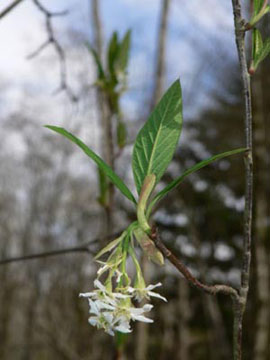
Oemleria cerasiformis
Osoberry is a fast-growing, multi-stemmed shrub to small tree with reddish to purplish-brown bark. In open sunny locations it may form a dense shrub, while in the shade it becomes more open to sprawling. This is one of our earliest flowering native shrubs, and its slender, lime-green leaves are one of the first signs that spring is on the way!
This woodland plant does best in moist areas with dappled shade, and can tolerate many soil types, including heavy clay.
In the early spring, both male and female osoberries produce dangling clumps of whitish flowers. Female plants will then produce small hard berries towards the end of summer (male plants produce no fruit). The fruit is peach-colored early in the season, maturing to blue-black in the fall, and is a favorite of many birds and small mammals. Osoberry also serves as a host for several caterpillar species, and the flowers are a source of nectar for butterflies, hummingbirds, and pollinators, making this an excellent wildlife plant.
- Light Requirements: Full Sun, Part Shade, Full Shade
- Water Requirements: Dry, Moist
- Ease of Growing: Easy to grow
- Growth Rate: Fast
- Spreads: No
- Wildlife Support: Birds or Mammals
- Fire-resistant: Yes
- Edible: Yes
- Mature Height: 15ft
- Mature Width:5-10ft
Cusick’s Checkermallow
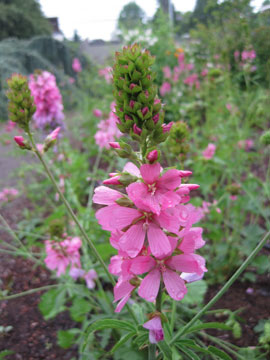
Sidalcea cusickii
A delightful, hollyhock-like perennial rarely found outside its native Oregon, and not in every county. Stands of this perennial have been reported in Washington, Multnomah, Yamhill, Benton, Linn, Lane, Douglas, Coos and Jackson counties, but not all are documented.
- Light Requirements: Full Sun, Part Shade
- Water Requirements: Dry, Moist
- Ease of Growing: Easy to grow
- Growth Rate: Fast
- Spreads:
- Wildlife Support: Pollinators, Birds or Mammals
- Fire-resistant: No
- Edible: Yes
- Mature Height: 4ft
- Mature Width:2ft
Lady Fern
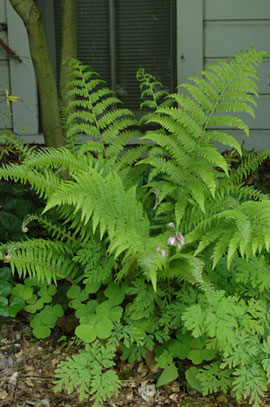
Athyrium filix-femina
Athyrium filix-femina (Lady Fern or Common Lady-fern) is a large, feathery species of fern native throughout most of the temperate Northern Hemisphere, where it is often abundant (one of the more common ferns) in damp, shady woodland environments and is often grown for decoration in shady home gardens.
- Light Requirements: Full Sun, Part Shade, Full Shade
- Water Requirements: Moist, Seasonally Wet
- Ease of Growing: Easy to grow
- Growth Rate: Moderate
- Spreads: No
- Wildlife Support: Hummingbirds, Birds or Mammals
- Fire-resistant: No
- Edible: No
- Mature Height: 4ft
- Mature Width:2ft
Wood Strawberry

Fragaria vesca ssp. bracteata
After flowering, rounded, egg-shaped, red edible berries appear in the late summer and early autumn. These appear to be smooth coated but are in fact covered in very short hairs, visible only at close range.
- Light Requirements: Full Sun, Part Shade
- Water Requirements: Dry, Moist
- Ease of Growing: Easy to grow
- Growth Rate: Moderate
- Spreads: Yes
- Wildlife Support: Birds or Mammals
- Fire-resistant: Yes
- Edible: Yes
- Mature Height: 6in
- Mature Width:1ft

